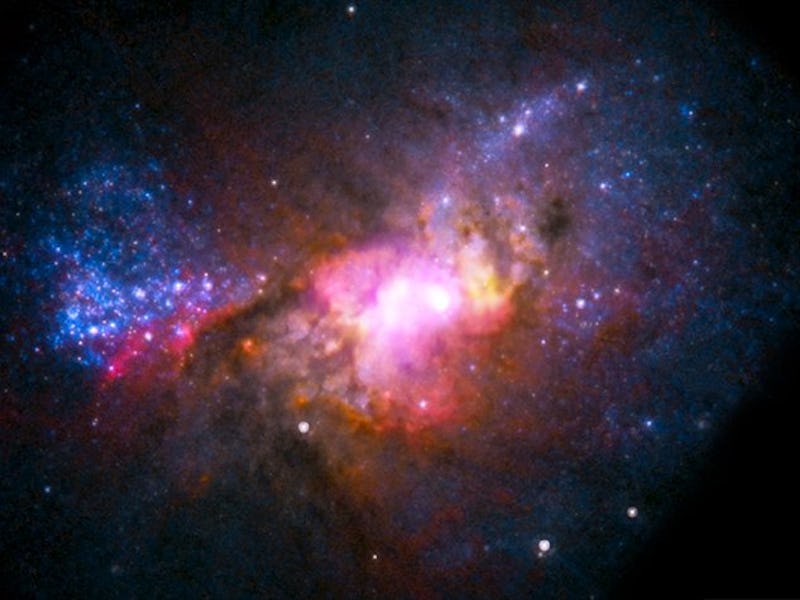New study reveals the gentler side of black holes
This tiny galaxy has a huge black hole at its center that’s churning out stars.

Black holes are largely misunderstood. Yes, these gigantic, dark beasts consume any celestial object that dares come too close, but it’s not all destruction with black holes. Sometimes, black holes actually make way for new cosmic life.
Scientists observed a black hole birthing new stars in a dwarf galaxy for the first time, providing evidence as to how these all-consuming objects can create stellar nurseries. The observations also reveal how ancient black holes may have formed shortly after the Big Bang.
The findings are detailed in a study published Wednesday in the journal Nature.
HERE’S THE BACKGROUND — Black holes are compact, dense concentrations of matter in space, a region with such a strong gravitational pull that not even light can escape.
Scientists believe that a black hole lurks at the center of every galaxy, but the case of this particular galaxy proved to be quite peculiar.
Henize 2-10 is an irregularly shaped dwarf galaxy, meaning that it is much smaller than the Milky Way and with much fewer stars. The galaxy lies 30 million light years away from Earth and has one-tenth the number of stars found in the Milky Way.
And yet, at its center lies an unusually large supermassive black hole, a million times the mass of the Sun or about a quarter as large as the black hole at the center of the Milky Way.
This illustrated image shows the black hole at the center of the dwarf galaxy, and its star-forming region.
“Ten years ago, as a graduate student thinking I would spend my career on star formation, I looked at the data from Henize 2-10 and everything changed,” Amy Reines, an astrophysicist at Montana State University, and lead author of the new study, said in a statement. “From the beginning I knew something unusual and special was happening in Henize 2-10.”
WHAT’S NEW — The discovery of the galaxy’s supermassive black hole led scientists to believe that perhaps black holes form first, and the formation of the galaxy that houses them follows.
Aside from its unusual fit, Henize 2-10 also had a bridge of hot gas that stretches across 230 light years and connects the galaxy’s supermassive black hole with its star-forming region.
Using the Hubble Space Telescope, the team of scientists behind the study measured the speed of the outflow of gas at about 1 million miles per hour. The outflow then slams into the dense gas of the star-forming region, with baby stars marking its path.
Most black holes emit jets of material moving at close to the speed of light. As black holes swallow up material to feed on, some of that material can also shoot out in the form of these jets.
But once the jets hit gas clouds in their way, those gas clouds become far too hot to be hospitable for newborn stars, leading scientists to question what role black holes can play in star formation. But the outflow of the black hole at the center of Henize 2-10 is gentle enough to birth stars.
The latest discovery shows the duality of black holes, balancing out their ferocious behavior of shredding stars apart and swallowing them up with their more gentle side of building stellar nurseries.
WHAT’S NEXT — At only 30 million miles away, the Henize 2-10 galaxy is an ideal candidate for observations. While most dwarf galaxies are too small or faint to capture, Hubble provided both images and spectroscopic measurements of the galaxy.
And with its black hole at the center, Henize 2-10 will not only provide new data on dwarf galaxies, but also on the relationship between dwarf galaxies and their black hole companions.
Dwarf galaxies serve as an analog for ancient galaxies that formed during the early history of the universe since they did not go through advanced stages of galaxy growth by merging with other galaxies. Learning more about dwarf galaxies will help scientists better understand how the earliest black holes formed and whether their host galaxies came to be before or after their formation.
“The era of the first black holes is not something that we have been able to see, so it really has become the big question: where did they come from?” Reines said. “Dwarf galaxies may retain some memory of the black hole seeding scenario that has otherwise been lost to time and space.”
Abstract: Black-hole-driven outflows have been observed in some dwarf galaxies with active galactic nuclei1, and probably play a role in heating and expelling gas (thereby suppressing star formation), as they do in larger galaxies2. The extent to which black-hole outflows can trigger star formation in dwarf galaxies is unclear, because work in this area has previously focused on massive galaxies and the observational evidence is scarce3,4,5. Henize 2-10 is a dwarf starburst galaxy previously reported to have a central massive black hole6,7,8,9, although that interpretation has been disputed because some aspects of the observational evidence are also consistent with a supernova remnant10,11. At a distance of approximately 9 Mpc, it presents an opportunity to resolve the central region and to determine if there is evidence for a black-hole outflow influencing star formation. Here we report optical observations of Henize 2-10 with a linear resolution of a few parsecs. We find an approximately 150-pc-long ionized filament connecting the region of the black hole with a site of recent star formation. Spectroscopy reveals a sinusoid-like position–velocity structure that is well described by a simple precessing bipolar outflow. We conclude that this black-hole outflow triggered the star formation.